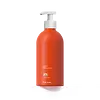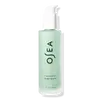What's inside
What's inside
 Key Ingredients
Key Ingredients

 Benefits
Benefits

 Concerns
Concerns

No concerns
 Ingredients Side-by-side
Ingredients Side-by-side

Water
Skin ConditioningC12-15 Alkyl Benzoate
AntimicrobialGlycerin
HumectantAloe Barbadensis Leaf Juice
Skin ConditioningCoco-Caprylate/Caprate
EmollientHydroxyethyl Acrylate/Sodium Acryloyldimethyl Taurate Copolymer
Emulsion Stabilising1,2-Hexanediol
Skin ConditioningC13-14 Alkane
SolventC15-23 Alkane
SolventCaprylyl Glycol
EmollientCitric Acid
BufferingCitrus Aurantifolia Fruit Extract
Skin ConditioningDecyl Glucoside
CleansingFucus Vesiculosus
Skin ConditioningAlgae
Skin ConditioningKappaphycus Alvarezii Extract
Skin ConditioningLeuconostoc/Radish Root Ferment Filtrate
AntimicrobialMelia Azadirachta Flower Extract
Skin ConditioningMelia Azadirachta Leaf Extract
Skin ConditioningOlea Europaea Fruit Oil
MaskingSodium Benzoate
MaskingPotassium Sorbate
PreservativePanthenol
Skin ConditioningSodium Sulfite
PreservativeSea Water
HumectantSodium Polyacrylate Starch
AbsorbentTerminalia Ferdinandiana Fruit Extract
AntioxidantTropolone
Skin Conditioning2,6-Dimethyl-7-Octen-2-Ol
MaskingCedrus Atlantica Wood Oil
PerfumingCistus Ladaniferus Resin
MaskingDodecahydro-Tetramethylnaphthofuran
PerfumingEthyl Hydroxypyrone
MaskingFusanus Spicatus Wood Oil
MaskingGamma-Decalactone
PerfumingGamma-Octalactone
PerfumingGamma-Valerolactone
PerfumingJuniperus Virginiana Oil
MaskingMyrtus Communis Oil
MaskingOctanal
PerfumingPhenethyl Alcohol
MaskingPogostemon Cablin Leaf Oil
MaskingThuja Plicata Wood Oil
MaskingTriethyl Citrate
MaskingWater, C12-15 Alkyl Benzoate, Glycerin, Aloe Barbadensis Leaf Juice, Coco-Caprylate/Caprate, Hydroxyethyl Acrylate/Sodium Acryloyldimethyl Taurate Copolymer, 1,2-Hexanediol, C13-14 Alkane, C15-23 Alkane, Caprylyl Glycol, Citric Acid, Citrus Aurantifolia Fruit Extract, Decyl Glucoside, Fucus Vesiculosus, Algae, Kappaphycus Alvarezii Extract, Leuconostoc/Radish Root Ferment Filtrate, Melia Azadirachta Flower Extract, Melia Azadirachta Leaf Extract, Olea Europaea Fruit Oil, Sodium Benzoate, Potassium Sorbate, Panthenol, Sodium Sulfite, Sea Water, Sodium Polyacrylate Starch, Terminalia Ferdinandiana Fruit Extract, Tropolone, 2,6-Dimethyl-7-Octen-2-Ol, Cedrus Atlantica Wood Oil, Cistus Ladaniferus Resin, Dodecahydro-Tetramethylnaphthofuran, Ethyl Hydroxypyrone, Fusanus Spicatus Wood Oil, Gamma-Decalactone, Gamma-Octalactone, Gamma-Valerolactone, Juniperus Virginiana Oil, Myrtus Communis Oil, Octanal, Phenethyl Alcohol, Pogostemon Cablin Leaf Oil, Thuja Plicata Wood Oil, Triethyl Citrate
Water
Skin ConditioningPropanediol
SolventPropanediol Dicaprylate/Caprate
EmollientGlycerin
HumectantCoconut Alkanes
EmollientSpirulina Platensis Extract
Skin ProtectingNiacinamide
SmoothingCaffeine
Skin ConditioningAmmonium Acryloyldimethyltaurate/Vp Copolymer
Betaine
HumectantHaematococcus Pluvialis Extract
AntioxidantHaematococcus Pluvialis Oil
AntioxidantCodium Fragile Extract
Skin ConditioningAloe Barbadensis Leaf Juice
Skin ConditioningSodium Hyaluronate
HumectantHydrolyzed Glycosaminoglycans
HumectantHydrolyzed Hyaluronic Acid
HumectantHyaluronic Acid
HumectantTremella Fuciformis Polysaccharide
Emulsion StabilisingPolyglutamic Acid
Skin ConditioningLactobacillus Ferment
Skin ConditioningCoco-Caprylate/Caprate
EmollientCetearyl Olivate
Sorbitan Olivate
Emulsifying1,2-Hexanediol
Skin ConditioningXanthan Gum
EmulsifyingEthylhexylglycerin
Skin ConditioningTrisodium Ethylenediamine Disuccinate
Citric Acid
BufferingPotassium Sorbate
PreservativeCaprylhydroxamic Acid
Sodium Benzoate
MaskingPhenoxyethanol
PreservativeCopper Chlorophyll
Cosmetic ColorantWater, Propanediol, Propanediol Dicaprylate/Caprate, Glycerin, Coconut Alkanes, Spirulina Platensis Extract, Niacinamide, Caffeine, Ammonium Acryloyldimethyltaurate/Vp Copolymer, Betaine, Haematococcus Pluvialis Extract, Haematococcus Pluvialis Oil, Codium Fragile Extract, Aloe Barbadensis Leaf Juice, Sodium Hyaluronate, Hydrolyzed Glycosaminoglycans, Hydrolyzed Hyaluronic Acid, Hyaluronic Acid, Tremella Fuciformis Polysaccharide, Polyglutamic Acid, Lactobacillus Ferment, Coco-Caprylate/Caprate, Cetearyl Olivate, Sorbitan Olivate, 1,2-Hexanediol, Xanthan Gum, Ethylhexylglycerin, Trisodium Ethylenediamine Disuccinate, Citric Acid, Potassium Sorbate, Caprylhydroxamic Acid, Sodium Benzoate, Phenoxyethanol, Copper Chlorophyll
 Reviews
Reviews

Alternatives
Ingredients Explained
These ingredients are found in both products.
Ingredients higher up in an ingredient list are typically present in a larger amount.
1,2-Hexanediol is a synthetic liquid and another multi-functional powerhouse.
It is a:
- Humectant, drawing moisture into the skin
- Emollient, helping to soften skin
- Solvent, dispersing and stabilizing formulas
- Preservative booster, enhancing the antimicrobial activity of other preservatives
Aloe Barbadensis Leaf Juice comes from leaves of the aloe plant. Aloe Barbadensis Leaf Juice is best known for helping to soothe sunburns. It is also anti-inflammatory, moisturizing, antiseptic, and can help heal wounds.
Aloe is packed with good stuff including Vitamins A, C, and E. These vitamins are antioxidants, which help fight free-radicals and the damage they may cause. Free-radicals are molecules that may damage your skin cells, such as pollution.
Aloe Barbadensis Leaf Juice also contains sugars. These sugars come in the form of monosaccharides and polysaccharides, folic acid, and choline. These sugars are able to help bind moisture to skin.
It also contains minerals such as calcium, 12 anthraquinones, fatty acids, amino acids, and Vitamin B12.
Learn more about Aloe Barbadensis Leaf JuiceCitric Acid is an alpha hydroxy acid (AHA) naturally found in citrus fruits like oranges, lemons, and limes.
Like other AHAs, citric acid can exfoliate skin by breaking down the bonds that hold dead skin cells together. This helps reveal smoother and brighter skin underneath.
However, this exfoliating effect only happens at high concentrations (20%) which can be hard to find in cosmetic products.
Due to this, citric acid is usually included in small amounts as a pH adjuster. This helps keep products slightly more acidic and compatible with skin's natural pH.
In skincare formulas, citric acid can:
While it can provide some skin benefits, research shows lactic acid and glycolic acid are generally more effective and less irritating exfoliants.
Most citric acid used in skincare today is made by fermenting sugars (usually from molasses). This synthetic version is identical to the natural citrus form but easier to stabilize and use in formulations.
Read more about some other popular AHA's here:
Learn more about Citric AcidCoco-Caprylate/Caprate is created from fatty coconut alcohol, caprylic acid, and capric acid.
It is a lightweight emollient. Emollients create a thin barrier on the skin to trap moisture in. This helps keep your skin hydrated and soft.
Once applied, Coco-Caprylate/Caprate is absorbed quickly and leaves a silky feel.
Coco-Caprylate/Caprate may not be fungal acne safe.
Learn more about Coco-Caprylate/CaprateGlycerin is already naturally found in your skin. It helps moisturize and protect your skin.
A study from 2016 found glycerin to be more effective as a humectant than AHAs and hyaluronic acid.
As a humectant, it helps the skin stay hydrated by pulling moisture to your skin. The low molecular weight of glycerin allows it to pull moisture into the deeper layers of your skin.
Hydrated skin improves your skin barrier; Your skin barrier helps protect against irritants and bacteria.
Glycerin has also been found to have antimicrobial and antiviral properties. Due to these properties, glycerin is often used in wound and burn treatments.
In cosmetics, glycerin is usually derived from plants such as soybean or palm. However, it can also be sourced from animals, such as tallow or animal fat.
This ingredient is organic, colorless, odorless, and non-toxic.
Glycerin is the name for this ingredient in American English. British English uses Glycerol/Glycerine.
Learn more about GlycerinPotassium Sorbate is a preservative used to prevent yeast and mold in products. It is commonly found in both cosmetic and food products.
This ingredient comes from potassium salt derived from sorbic acid. Sorbic acid is a natural antibiotic and effective against fungus.
Both potassium sorbate and sorbic acid can be found in baked goods, cheeses, dried meats, dried fruit, ice cream, pickles, wine, yogurt, and more.
You'll often find this ingredient used with other preservatives.
Learn more about Potassium SorbateSodium Benzoate is a preservative. It's used in both cosmetic and food products to inhibit the growth of mold and bacteria. It is typically produced synthetically.
Both the US FDA and EU Health Committee have approved the use of sodium benzoate. In the US, levels of 0.1% (of the total product) are allowed.
Sodium benzoate works as a preservative by inhibiting the growth of bacteria inside of cells. It prevents the cell from fermenting a type of sugar using an enzyme called phosphofructokinase.
It is the salt of benzoic acid. Foods containing sodium benzoate include soda, salad dressings, condiments, fruit juices, wines, and snack foods.
Studies for using ascorbic acid and sodium benzoate in cosmetics are lacking, especially in skincare routines with multiple steps.
We always recommend speaking with a professional, such as a dermatologist, if you have any concerns.
Learn more about Sodium BenzoateWater. It's the most common cosmetic ingredient of all. You'll usually see it at the top of ingredient lists, meaning that it makes up the largest part of the product.
So why is it so popular? Water most often acts as a solvent - this means that it helps dissolve other ingredients into the formulation.
You'll also recognize water as that liquid we all need to stay alive. If you see this, drink a glass of water. Stay hydrated!
Learn more about Water